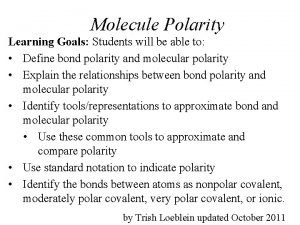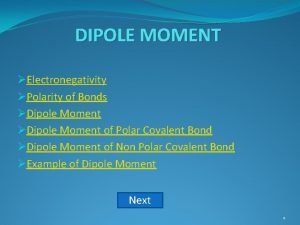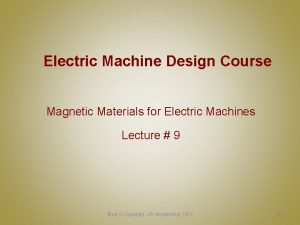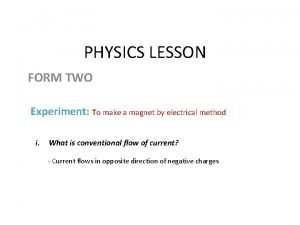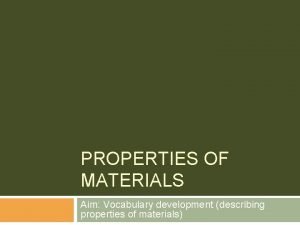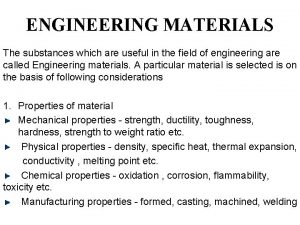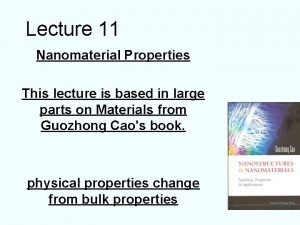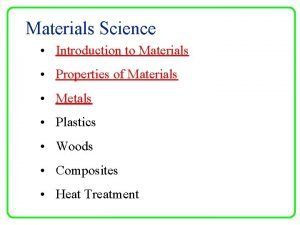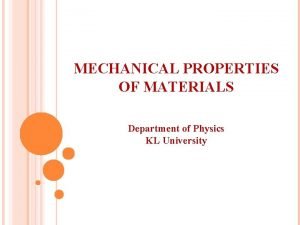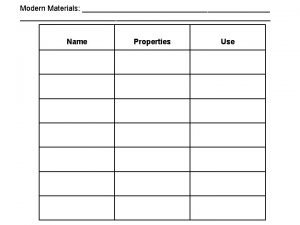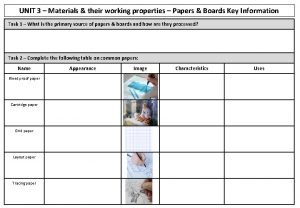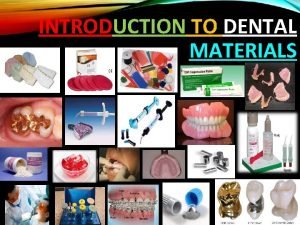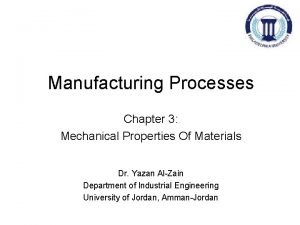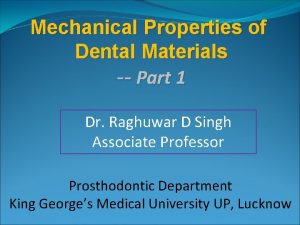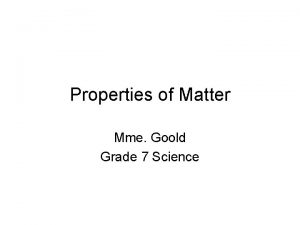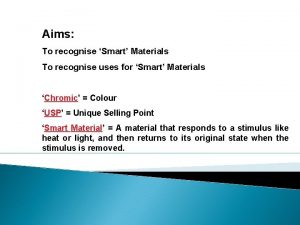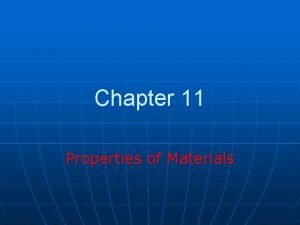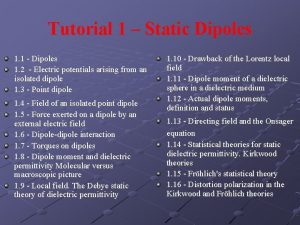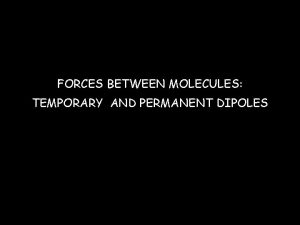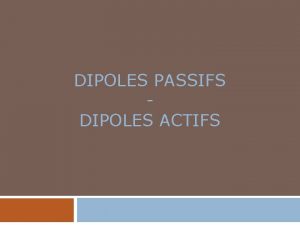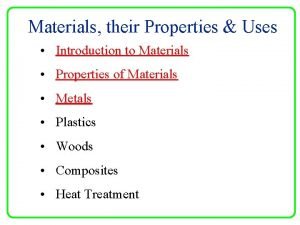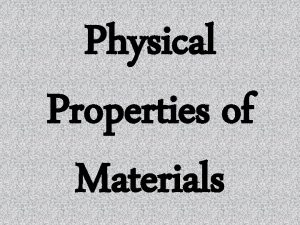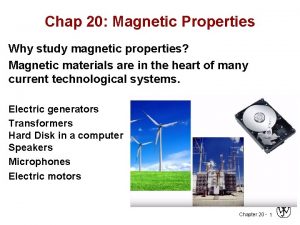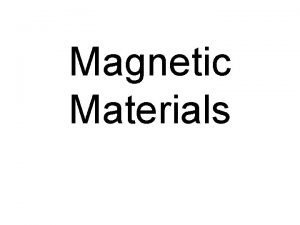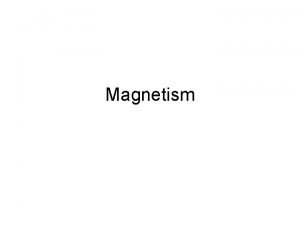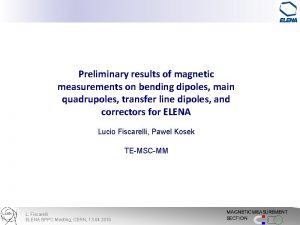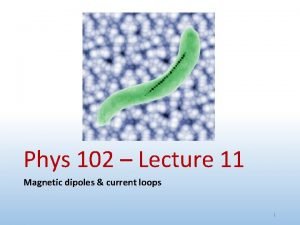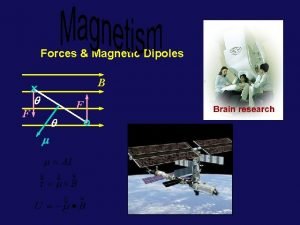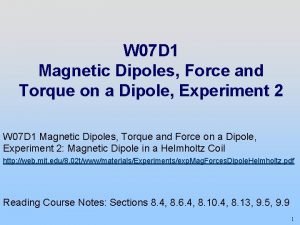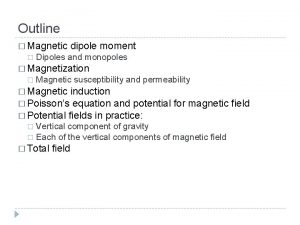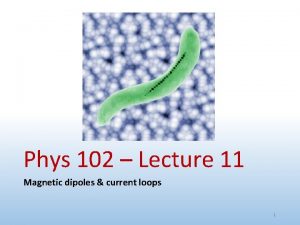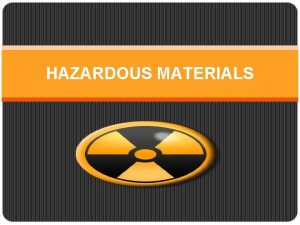Magnetic Properties of Materials 1 Magnetic Dipoles Magnetic


























- Slides: 26

Magnetic Properties of Materials 1

Magnetic Dipoles Magnetic field lines of force around a current loop and a bar magnet 2

Applied Magnetic Field • Created by current through a coil: Applied magnetic field H N = total number of turns L = length of each turn current I • Relation for the applied magnetic field, H: current applied magnetic field units = (ampere-turns/m) 3

Response to a Magnetic Field • Magnetic induction results in the material B = Magnetic Induction (tesla) inside the material current I • Magnetic susceptibility, c (dimensionless) B c >0 vacuum c = 0 c<0 H 4 c measures the material response relative to a vacuum.

Magnetic Field Vectors Flux Density Relative Permeability (Magnetization) Magnetic Susceptibility 5

Magnetic Field Vectors Magnetic Units and Conversion Factors for the SI and cgs–emu Systems 6

Origins of Magnetic Moments • Measures the response of electrons to a magnetic field. • Electrons produce magnetic moments: magnetic moments electron spin nucleus • Net magnetic moment: --sum of moments from all electrons. 7

Types of Magnetism permeability of a vacuum: (1. 26 x 10 -6 Henries/m) Magnetic induction B (tesla) (3) ferromagnetic e. g. Fe 3 O 4, Ni. Fe 2 O 4 ferrimagnetic e. g. ferrite( ), Co, Ni, Gd ( c as large as 106 !) (2) paramagnetic ( c ~ 10 -4) e. g. , Al, Cr, Mo, Na, Ti, Zr vacuum (c = 0) (1) diamagnetic ( c ~ -10 -5) e. g. , Al 2 O 3 , Cu, Au, Si, Ag, Zn Strength of applied magnetic field (H) (ampere-turns/m) 8

Magnetic Moments for 3 Types (2) paramagnetic random aligned (3) ferromagnetic ferrimagnetic aligned opposing Applied Magnetic Field (H) aligned (1) diamagnetic none No Applied 9 Magnetic Field (H = 0)

Diamagnetism - Diamagnetic materials are attracted towards regions where the field is weak - Relative permeability µr is less than unity - Negative magnetic susceptibility

Diamagnetism and Paramagnetism 11 Schematic representation of the flux density B versus the magnetic field strength H for diamagnetic and paramagnetic materials. Diamagnetism and paramagnetism materials are considers to non magnetic because they exhibit magnetization only when in the presence of an external field.

Diamagnetism and Paramagnetism 12 Room-Temperature Magnetic Susceptibilities for Diamagnetic and Paramagnetic Materials

Ferromagnetism Ø A permanent magnetic moment in the absence of an internal field due to electron spin – uncancelled electron spin and small contribution of orbital magnetic moment Ø Manifest very large and permanent magnetization Ø Magnetic susceptibilities is high

Domains and Hysteresis 14 Schematic depiction of domains in a ferromagnetic material; arrows represent atomic magnetic dipoles. Within each domain, all dipoles are aligned, whereas the direction of alignment varies from one domain to another.

Domains and Hysteresis 15 The gradual change in magnetic dipole orientation across a domain wall

Domains and Hysteresis • As the applied field (H) increases. . . --the magnetic moment aligns with H. B sat H Magnetic induction (B) H H 0 • “Domains” with aligned magnetic moment grow at expense of poorly aligned ones! Applied Magnetic Field (H) H=0 16

Domains and Hysteresis Magnetic flux density versus the magnetic field strength for a ferromagnetic material that is subjected to forward and reverse saturations (points S and S’). The hysteresis loop is represented by the solid curve; the dashed curve indicates the initial magnetization. The remanence Br and the coercive force Hc are also shown. 17

Domains and Hysteresis 18

Domains and Hysteresis A hysteresis curve at less than saturation (curve NP) within the saturation loop for a ferromagnetic material. The B–H behavior field reversal at other than saturation is indicated by curve LM. 19

Domains and Hysteresis Comparison of B-versus-H behaviors for ferromagnetic and diamagnetic/ paramagnetic materials (inset plot). Small B fields are generated in materials that experience only diamagnetic/paramagnetic behavior, which is why they are considered to be non-magnetics 20

Permanent Magnets B • Process: 2. apply H, cause alignment 3. remove H, alignment stays! => permanent magnet! Adapted from Fig. 20. 14, Callister 7 e. 4. Coercivity, HC Negative H needed to demagnitize! 1. initial (unmagnetized state) B Soft Hard • Hard vs Soft Magnets large coercivity --good for perm magnets --add particles/voids to make domain walls hard to move (e. g. , tungsten steel: Hc = 5900 amp-turn/m) Applied Magnetic Field (H) small coercivity--good for elec. motors (e. g. , commercial iron 99. 95 Fe) 21

Soft Magnetic Materials • Ferromagnetic is classified as either soft or hard on the basis of their hysteresis characteristics. • Soft magnetic materials are used in devices that are subjected to alternating magnetic fields • Losses must be low, one familiar example is transformer cores. • Magnetization curves for soft and hard magnetic materials. Relative area within the hysteresis loop must be small (it is characteristically thin and narrow) • A soft magnetic material must have a high initial permeability and a low coercivity. A material possessing these properties may reach its saturation magnetization with a relatively low applied field (i. e. , is easily magnetized and demagnetized) and still has lowhysteresis energy losses. 22

Soft Magnetic Materials Another property consideration for soft magnetic materials is electrical resistivity. Energy losses may result from electrical currents that are induced in a magnetic material by a magnetic field that varies in magnitude and direction with time; these are called eddy currents. It is most desirable to minimize these energy losses in soft magnetic materials by increasing the electrical resistivity. This is accomplished in ferromagnetic materials by forming solid solution alloys; iron–silicon and iron– nickel alloys are examples. The ceramic ferrites are commonly used for applications requiring soft magnetic materials because they are intrinsically electrical insulators. The hysteresis characteristics of soft magnetic materials may be enhanced for some applications by an appropriate heat treatment in the presence of a magnetic field. Using such a technique, a square hysteresis loop may be produced, which is desirable in some magnetic amplifier and pulse transformer applications. In addition, soft magnetic materials are used in generators, motors, dynamos, and switching circuits. 23

Typical Properties for Several Soft Magnetic Materials 24

Hard Magnetic Materials • Hard magnetic materials are utilized in permanent magnets • High resistance to demagnetization. • High remanence, coercivity, and saturation flux density, as well as a low initial permeability, and high hysteresis energy losses. Schematic magnetization curve displays hysteresis. The second quadrant are drawn two B–H energy that product rectangles; the area of that rectangle labeled (BH)max which is greater than the area defined by Bd –Hd. 25

Summary • A magnetic field can be produced by: -- putting a current through a coil. • Magnetic induction: -- occurs when a material is subjected to a magnetic field. -- is a change in magnetic moment from electrons. • Types of material response to a field are: -- ferri- or ferro-magnetic (large magnetic induction) -- paramagnetic (poor magnetic induction) -- diamagnetic (opposing magnetic moment) • Hard magnets: large coercivity. • Soft magnets: small coercivity. 26
 Relationship between bond dipoles and molecular dipoles
Relationship between bond dipoles and molecular dipoles Dipole moment and polarity
Dipole moment and polarity Go noodle cant stop the feeling
Go noodle cant stop the feeling Direct materials budget with multiple materials
Direct materials budget with multiple materials All materials found at home are useful
All materials found at home are useful Natural materials and man made materials
Natural materials and man made materials Adopting materials
Adopting materials Electric field and magnetic field difference
Electric field and magnetic field difference Magnetic materials used in electrical machines
Magnetic materials used in electrical machines Define magnetic materials
Define magnetic materials Distinguish between magnetic and nonmagnetic materials
Distinguish between magnetic and nonmagnetic materials Magnetic retentivity
Magnetic retentivity Properties of materials vocabulary
Properties of materials vocabulary Natural science grade 7 term 2 matter and materials
Natural science grade 7 term 2 matter and materials What is the engineering materials
What is the engineering materials Hardness of nanomaterials
Hardness of nanomaterials Properties of materials examples
Properties of materials examples Manufacturing property of a material
Manufacturing property of a material Longitudinal strain
Longitudinal strain Stomatex fabric
Stomatex fabric Solid white board characteristics
Solid white board characteristics Ideal requirements of dental materials
Ideal requirements of dental materials Manufacturing properties of materials
Manufacturing properties of materials Stress strain curve toughness
Stress strain curve toughness Classification of matter grade 7
Classification of matter grade 7 Properties of smart and modern materials
Properties of smart and modern materials Properties of materials examples
Properties of materials examples
